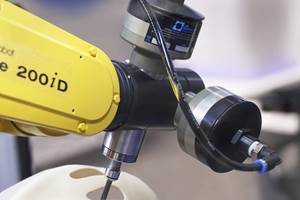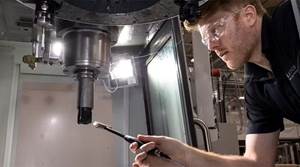How to Tackle Tough Angled Pocket Milling With Two Tools
Milling a deep pocket with a tight corner radius comes with unique challenges, but using both a flat bottom drill and a necked-down finishing tool can help.
Share






Reader Question
I have an application where I am milling a deep pocket in 6061 with a tight corner radius — 3/16 inch — into an angled surface. The maximum depth of the pocket is 1 inch deep (5× deep). The pocket is inside of another pocket, so toolholder clearance is also a problem. What’s more, the cut is very prone to chatter. How can I successfully mill this pocket?
Miller’s Advice
Pockets like this are tricky because of so many competing factors, but identifying the overlying issues and constraints is a good first step to developing a solution. Ideally, you could use a larger tool, but you’re constrained by the pocket radius. Shortening the tool stick could help, but the primary pocket makes this impossible. The angled surface also leads to some interesting limitations as far as tool selection.
Even after you’ve selected the tool, the cut is prone to chatter, so you must determine the magnitude and direction of the cutting forces, as well as the system’s stiffness. Getting the cutting forces up into the spindle can be a huge benefit in this application, just like high feed milling in hard metals. Any cutting forces normal to the tool are the enemy. While you can’t eliminate all normal forces — given the pocket geometry, you must finish-mill the cut — you can reduce them. Anything you can do to add rigidity near the cut will also improve stiffness. Because this is a pocket within a pocket, you’ll also face significant clearance limitations.
With these difficulties in mind, it’s time to dive into the different components, and solve each as best as possible given the constraints.
The first thing you are up against is the tool diameter. Unfortunately, barring any design changes, the 3/16-inch tool at 5× deep is here to stay. Since you can’t change it, work with it. You want to reduce the amount of work you’re asking of this tool as much as possible.
One reduction strategy would be to use separate tools for finishing and roughing. A two-tool strategy will reduce the load on the tiny finisher and provide better tool life. It could even shorten the cycle time compared to a single-tool process — roughing’s increased productivity can counterbalance any time added for tool change and positioning.
Next, address the pocket. Since your challenging pocket is within another pocket, you can’t change much with the tool holder to increase stiffness. Yet you still need as much support as you can get, as close as possible to the cutting point. In this instance, a necked-down end mill (an end mill with a larger shank than cutting diameter) is wise. This will give you more stiffness where the tool holder can’t fit without rubbing against other critical features of the part.
The angled surface is the most unique aspect of this cutting problem. Drilling out difficult pockets is typically a good solution. Drilling provides high removal rates, and the forces go where the machine and tool setup are strongest. In fact, it’s a common strategy in large titanium or hard metal parts. However, the angled surface changes that formula a bit. Fortunately, indexable drills or solid carbide flat-bottom drills are up to the task. These drills also have the benefit of being able to drill overlapping holes! Given how small this pocket is, perhaps a carbide flat-bottom drill is ideal here. It can fit tightly into that 3/16-inch radius and leave minimal material in the area at highest risk for chatter.
Bringing together these solutions, start by switching to a two-tool process. The first tool should be a 4- or 4.5-mm flat bottom drill (just smaller than the finish radius) for roughing the entire pocket, leaving only small scallops and a little floor material left for finishing. The second, necked-down finishing tool will greatly improve the overall stiffness, and when combined with the minimal finishing stock, should enable a more productive finishing operation.
Related Content
Briquetting Manufacturer Tools Up for Faster Turnaround Times
To cut out laborious manual processes like hand-grinding, this briquette manufacturer revamped its machining and cutting tool arsenal for faster production.
Read MoreHow to Accelerate Robotic Deburring & Automated Material Removal
Pairing automation with air-driven motors that push cutting tool speeds up to 65,000 RPM with no duty cycle can dramatically improve throughput and improve finishing.
Read MoreHow to Mitigate Chatter to Boost Machining Rates
There are usually better solutions to chatter than just reducing the feed rate. Through vibration analysis, the chatter problem can be solved, enabling much higher metal removal rates, better quality and longer tool life.
Read MoreOrthopedic Event Discusses Manufacturing Strategies
At the seminar, representatives from multiple companies discussed strategies for making orthopedic devices accurately and efficiently.
Read MoreRead Next
AMRs Are Moving Into Manufacturing: Considerations for Implementation
AMRs can provide a flexible, easy-to-use automation platform so long as manufacturers choose a suitable task and prepare their facilities.
Read MoreLast Chance! 2025 Top Shops Benchmarking Survey Still Open Through April 30
Don’t miss out! 91ÊÓƵÍøÕ¾ÎÛ's Top Shops Benchmarking Survey is still open — but not for long. This is your last chance to a receive free, customized benchmarking report that includes actionable feedback across several shopfloor and business metrics.
Read MoreMachine Shop MBA
Making Chips and 91ÊÓƵÍøÕ¾ÎÛ are teaming up for a new podcast series called Machine Shop MBA—designed to help manufacturers measure their success against the industry’s best. Through the lens of the Top Shops benchmarking program, the series explores the KPIs that set high-performing shops apart, from machine utilization and first-pass yield to employee engagement and revenue per employee.
Read More






















